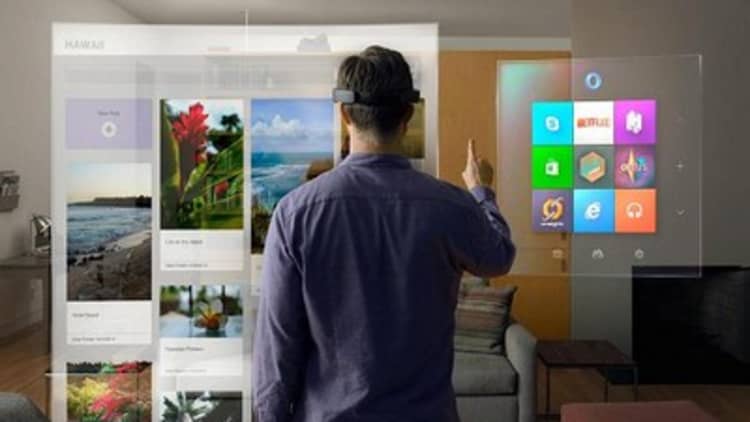While Silicon Valley is busy innovating in wearables, Sin City is putting the new technology to an old use.
Floor managers in Las Vegas have recently put wearables to the test by pinging staff when a high-roller approaches. Alerted by a discreet buzz, employees can glance at their wrist and put a name to the face, making sure the VIP continues to feel like one.
"Little tweaks like that are not purely revenue generating, but they are part of the brand experience," said Jim Haviland, chief strategy officer at mobility management services firm Vox Mobile.
Read More Salesforce wants to bring wearables to the workplace
The example illustrates two emerging trends in what is likely to be the year of the wearable. First: Whether or not wearables immediately boost cash flow, they can be very good for customer service, productivity and safety. Second: Smart accessories will likely show up first where they generate the highest returns.
The gaming industry is just one sector targeting smaller groups of premium customers with VIP service. Another is transportation.
Virgin Atlantic Airways partnered with air-transport specialist SITA to outfit employees at London Heathrow Airport with Google Glass to access information about first-class customers.
Elsewhere, retailers are piloting wearables to help associates optimize their time and improve customer experience, said Haviland. The technology can help managers prioritize tasks by notifying employees that something in the store requires their attention, he said.
It can also be deployed as retailers increasingly integrate online and in-store shopping through so-called omnichannel marketing. Associates would be able to access information about customers, such as product preferences and clothing size to make shopping more efficient.
Read More How to rent the Apple Watch before buying it
The benefit of outfitting associates with wearables may not be immediately clear, but Haviland said retail profit margins are so low that companies will seize any opportunity to improve the traditional point of sale—also known as the register—and make transactions throughout the store.
Early adopters are not limited to luxury and retail. According to surveys conducted by Vox, manufacturers were the most advanced users of wearables. That is in part because the form factor suits an industry in which workers need to keep their hands free.
"Field services and manufacturing I see as having even greater potential for higher returns than customer service at this point," Angela McIntyre, research director at Gartner, told CNBC.
Eyewear like Google Glass and the recently unveiled Microsoft HoloLens are catching on because the cost savings are apparent in several industries, particularly those in which companies send workers into remote areas, she said.

Microsoft has demonstrated how HoloLens would let a plumber help someone fix a bathroom sink by drawing virtual graphics over real-world piping.
McIntyre said an airline could put that functionality to use by connecting a specialist with a field engineer to troubleshoot a grounded plane, a situation that can cost air carriers $4,500 an hour.
HoloLens blurs the line between virtual reality and a category called augmented reality because it allows the user to see his or her physical environment, she said. Pure virtual reality headsets such as Facebook's Oculus Rift immerse the user in a wholly digital world.
Read More Microsoft regains its edge with hologram headset
The challenge, she said, is getting the machine-to-machine video to reliably align virtual graphics with real-world hardware and environments, even as workers are moving their heads.
Other industries are not so quick to get on board. Haviland said one of the laggards is an industry that has been flush with cash: Oil and gas.
In one case, Haviland said Vox was working with a small, innovative oilfield services company to deploy wearables, but the project fell apart after a much larger rival purchased the firm.
"They're not optimizing for safety. They're not optimizing for efficiency. They're optimizing for shareholder value," Haviland said. He declined to name the company.
Not everyone in the sector is behind the curve, though. Haviland noted that oilfield services company Baker Hughes is testing a wearable that monitors workers' vitals and can put out a "man down" alert.
In other cases, industries may put off adoption because wearables are simply too expensive.
Read MorePebble smartwatch sales now top 1 million: Report
Health-care providers are widely expected to use the technology to monitor patients after medical events such as surgery, but that development may not dovetail with the first wave of wearables.
Many health-care providers are billed on government contracts and face tough quarterly reporting standards, Haviland said. Consequently, there is little free cash flow available for investment, and he expects health care to remain at the back edge of innovation.
"You have to start seeing the costs of these things come down and commoditization before the business case makes sense, not because they don't add value, but they don't add value in the time frame they're allowed," Haviland said.
So while the Apple Watch may find its way into C-suites when it launches in April, he said, it could be some time before it trickles down to the boots on the ground.


